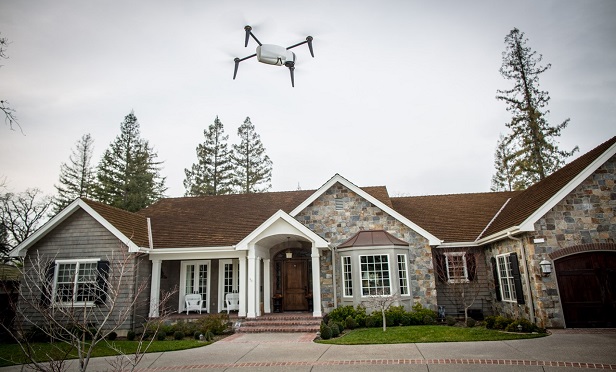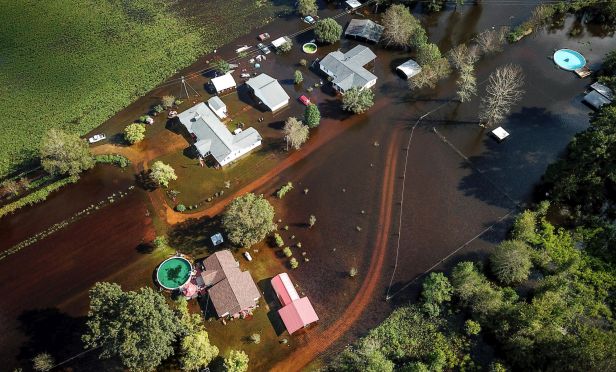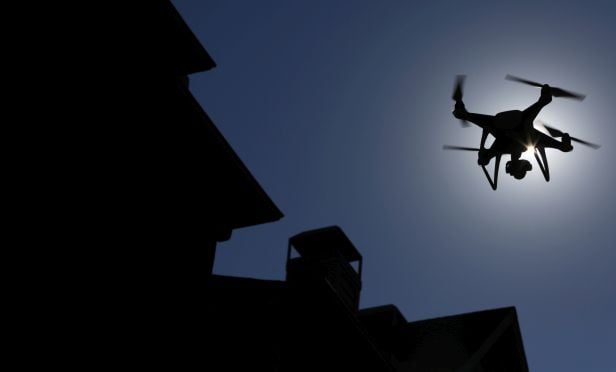Drones, or unmanned aerial systems (UAS), are rapidly gaining the attention of virtually every industry as a means of gaining greater efficiency in operations and reducing costs.
Drone use has grown exponentially over the past few years, following development of drones for personal and commercial use. Because the use of drones has grown so rapidly, it has been difficult to keep up with the opportunities they offer to industries, including the insurance industry.
While most of us have heard about Amazon's proposed use of drones to deliver packages to customers in 30 minutes or less, or Walmart's plan to use drones to handle inventory at its warehouses, there are many more uses being implemented, tested or proposed.
Law enforcement
There are approximately 34 U.S. agencies using drones in public safety and law enforcement, an increase of more than 500% over the past two years. The functions most advantageous to law enforcement offer not only efficiency in operations but improve safety and help save lives.
Some uses include bomb detection, search and rescue, traffic collisions, active shooter investigations, SWAT and tactical operations, analysis of crime scenes, surveillance operations and crowd monitoring. Anytime a drone can be used to go into a dangerous situation it improves the safety of our law enforcement and civilians, and a drone can capture a bird's eye view of crime scenes, accidents, disasters and searches more rapidly, in more minute detail, and in a less costly and less dangerous way than using only humans can.
3-D imaging
Drones can now be equipped with 3-D imaging and high-resolution cameras with video capabilities, enabling them to gather highly detailed renderings, which can be saved, analyzed and used for multiple purposes in a variety of applications. These uses include search and rescue, archaeological discovery, and construction or structural monitoring.
As evidenced by videos following Hurricanes Harvey and Irma, drones allow news organizations to provide real-time, close-up videos of events as they happen. Because they are operable any hour of the day or night, irrespective of weather conditions, drones are proving effective for security patrols over large commercial or industrial properties, securing the safety of the business as well as the staff.
Disasters
Drones, some no larger than a model airplane, were sent into areas of Texas and Florida to assess hurricane and flood damage. In Texas, 43 different organizations received special FAA authorization to operate drones in the hurricane areas. Some insurance companies were permitted to do inspections, as well as energy companies to ensure there were no oil or gas leaks.
Drones are nimble and fast, and their high-resolution cameras can zoom in and look inside buildings for damage and missing persons, all at a safe distance for the responders.
Agriculture
Agricultural drone use is beneficial for surveying, monitoring, and weed or disease management of large crops. In the future, there are predictions that swarms of bee-sized drones will be able to fly among farm fields, mapping the location of weeds with the help of onboard vision systems. However, the U.S. is unlikely to be able to use drones for crop surveys in the near future due to individual state licensing requirements and the need to comply with both FAA requirements and Part 337 chemical and toxic regulations.

Drones can be used to shoot video, take still photos, deliver medication and supplies, and inspect agricultural areas or train tracks after a major disaster. (Photo: Donan)
Construction
Drones can collect video footage for tracking and monitoring construction progress, and highlighting deficiencies or needed resources. The use of drones provides a way to monitor and evaluate resources and project status in real time, without interrupting work in progress while keeping workers and civilians safe from the project site.
Related: Do you need insurance for your drone?
Medical deliveries
Drones could transport medical samples and supplies, including defibrillators that could help revive people from cardiac arrests. A drone carrying an automated external defibrillator (AED) could be activated by a dispatcher and sent to an address provided by a 911 caller so anyone nearby can use it. They could also be sent into areas that may be inaccessible or otherwise difficult to quickly reach by other means.
Testing is taking place for drones to deliver medical supplies in rural Virginia, Bhutan and Papua New Guinea. UNICEF is testing the feasibility of using drones to transport lab samples in Malawi.
Inventory control
Drone-based wireless systems could scan and locate items in warehouses, and with each item identified by an RFID (radio frequency identifier) sticker, the drone could pinpoint an item's precise location. A drone operator could then dispatch a small drone equipped with its own RFID tag to fly throughout the warehouse, scanning, cataloging and localizing all of the RFID items in the warehouse. In addition to reducing the number of personnel needed to conduct inventories, drones also allow access to items normally requiring a ladder or lift to reach.
Hazardous equipment inspections
Drones offer a safer alternative for performing inspections of outdoor power and utility lines and equipment. Autonomous drones can capture minute details in the surrounding environment and acquire precise and reliable scan results for inspecting downed or damaged power lines, towers, wind turbine blades, mine shafts, dams, bridges, barges, electric and water utilities.
Related: FAA warns of drone impact risks with airplanes as use grows

Drones are providing critical claims information to adjusters faster than ever before, while reducing the physical risk for them at the same time. (Photo: Shutterstock)
Insurance claims process
Drones can also facilitate efficient claims adjusting. Adjusters must obtain an FAA Remote Pilot Certificate to fly drones, and be aware of the privacy regulations related to their use.
Drones are especially useful in gathering information following a disaster, going into dangerous areas where there are debris and downed trees and power lines. Drone use allows immediate data collection and risk monitoring to assess flood damage and direct claims adjusters on the ground. Before drone technology, it would have been weeks before adjusters could safely enter large flooded sites to assess damages.
Drones allow adjusters safe access to areas such as steep roofs to document accurate dimensions and take high-quality photos of damage. The drone-mounted cameras can zoom in to see damage on a single roof shingle.
Conducting regular inspections with drone cameras can record changes in the condition of property and areas of deterioration to help address latent problems before they become a major crisis.
Loss control and prevention
Companies can prevent losses as well as measure those that have already occurred by using drones to collect instantaneous and precise data, particularly from natural disasters. In some situations, drones can identify risks from disasters as they are happening ranging from volcanic eruptions to fires, floods and hurricanes. With the collection of real-time data, insurers could encourage people to avoid particularly risky areas, helping their customers avoid undue risk and perhaps saving lives.
They could also be used to capture data for a loss prevention survey in areas that are inaccessible to an engineer or surveyor. Areas such as dams, bridges, electric utilities, water towers and wastewater treatment facilities, asphalt plants, solar power farms, oil and gas operations, or other sites that pose specific risks are good candidates for drone inspections.
Real estate
The real estate industry is using drones to get better photographs and to market their listings. The detailed video drones capture, including remote access and large and dangerous terrain, assist the industry in showing or completing property boundaries, property surveys, property development, identifying surrounding areas, and the interior and exterior of buildings.
Entertainment
Drones can shoot high-resolution and 3D images for films, including quickly capturing strategic film scenes, video weddings and sports events. In addition, drones can operate in inclement weather that might prevent or distort other methods of capturing video.
Conservation
There are many conservation uses for drones ranging from thermal imaging to detect wildlife and people acting illegally, to searching for dolphins in the Amazon River and monitoring trees and forests. Drones facilitate wildlife management when used to track endangered species and to map out nesting areas that are in need of protection.
Other drone applications
Drone capabilities and uses continue to develop in tandem with advances in technology and artificial intelligence. These new uses require additional coverage and provide unique risks that must be addressed by insurers.
Related: Terror risk from small domestic drones has U.S officials worried
Karen L. Sorrell, CPCU, ([email protected]) is an editor with FC&S Online, the authority on insurance coverage interpretation and analysis for the P&C industry. She has an extensive background in commercial insurance underwriting. Visit www.NationalUnderwriter.com for additional information about FC&S Online, it's the resource agents, brokers, risk managers, underwriters, and adjusters rely on to research commercial and personal lines coverage issues.
Want to continue reading?
Become a Free PropertyCasualty360 Digital Reader
Your access to unlimited PropertyCasualty360 content isn’t changing.
Once you are an ALM digital member, you’ll receive:
- Breaking insurance news and analysis, on-site and via our newsletters and custom alerts
- Weekly Insurance Speak podcast featuring exclusive interviews with industry leaders
- Educational webcasts, white papers, and ebooks from industry thought leaders
- Critical converage of the employee benefits and financial advisory markets on our other ALM sites, BenefitsPRO and ThinkAdvisor
Already have an account? Sign In Now





